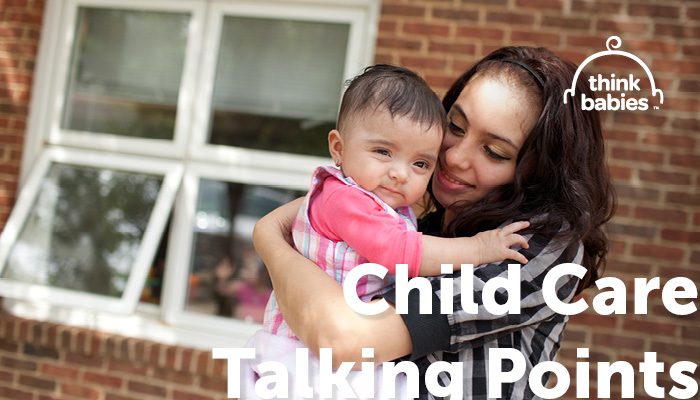Use these talking points to urge your fellow community members and your elected officials to Think Babies and prioritize family access to affordable, high-quality child care.
IN THIS RESOURCE
- Top 5 Child Care Talking Points:
- America’s Future Depends on Quality Child Care
- Quality Child Care Readies Babies for Success
- The Quality of the Relationship Between the Child Care Provider and Child Matters
- Children of Color Lack Equitable Access to Affordable, High-Quality Child Care
- Families Struggle to Afford the Child Care They Need
- Child Care is Crucial to Getting Families Back to Work after the COVID-19 Pandemic
- Policy Recommendations
It is Time to Think Babies™
- The science is clear. Our brains grow faster between the ages of 0 and 3 than at any later period in life, forming more than one million new neural connections every second.
- When babies have nurturing relationships, positive early learning experiences, and good health and nutrition, those neural connections are stimulated and strengthened, laying a strong foundation for the rest of their lives.
- When babies don’t get what their growing brains need to thrive, they don’t develop as they should. This leads to life-long developmental, educational, social, and health challenges.
Top 5 Child Care Talking Points:
1. Child care is a public good, essential to economic recovery and the development of the workforce of tomorrow.
2. Quality child care feeds a baby’s growing brain, building the foundation for the development and learning necessary for them to thrive as adults.
3. Center-based, infant child care remains “unaffordable,” according to the federal definition, in 50 states and Washington, D.C.– if it can be found at all.
4. Only 4.2% of low- and moderate-income infants and toddlers are served by the child care assistance available through the Child Care and Development Fund.
5. Families of color are less likely to be able to afford the high cost of infant-toddler child care, and more likely to live in communities that lack high-quality early care providers.
America’s Future Depends on Quality Child Care
- Families need access to quality and affordable child care that supports their babies’ healthy development.
- Today, the majority of women with infants (61% of mothers) return to the workforce within the first year after their child’s birth. More than half of children under the age of three (more than 6 million) spend some or all of their day being cared for by someone other than their parents.
- Quality child care is a public good, fueling our country’s economic engine by helping parents work, and also building the workforce of the future.
- But, unlike K-12 education, which is largely funded through public dollars, the United States places the majority of the burden for paying for child care on parents of young children, subsidized by the low wages of the early educators who provide care.
- Without adequate public investment, child care has always operated on slim margins. The COVID-19 pandemic increased the costs of operating safe care, even as enrollment dwindled. Many programs closed, affecting accessibility.
- As the nation copes with the long term impacts of COVID-19, families will need a broad array of options to meet their child care needs and return to the workforce. Policymakers must prioritize the robust investment the child care sector needs.
Quality Child Care Readies Babies for Success
- In the first three years of life, brain connections form at the rate of more than 1 million per second. Positive interactions with nurturing caregivers reinforce these connections, creating a strong foundation.
- Quality child care prepares babies for future learning and success. Outcomes include increased cognitive and communication skills, expanded vocabulary, better social and emotional skills, and higher scores on math and language measures over time.
- Quality care is tough to access, especially for those who need it most. Three out of four toddlers are in low or mediocre quality care settings that can be detrimental to their development.
- While policymakers may be tempted to relax regulations to save money in the child care system, the quality of care matters deeply to the health, safety and long term outcomes for children and communities. In fact, research shows that high-quality birth to five early childhood programs for under-resourced children can deliver a 13% per year return on investment.
The Quality of the Relationship Between the Child Care Provider and Child Matters
- These are four core elements of quality infant-toddler child care:
- A nurturing environment. The quality of child care ultimately boils down to the relationship between the child care provider and the child. To help children make connections that support their development, there should be no more than a 1:4 caregiver to child ratio and no more than eight children per group.
- A competent workforce. Caregivers and teachers should have specialized knowledge and skill in early childhood development, with a focus on infant and toddlers.
- A compensated workforce. Average child care wages are at the bottom of the occupational ladder at well under $12 an hour, despite extensive research showing that better paid staff are associated with better quality care.
- Continuity of care. One primary, but not exclusive, caregiver for at least one year, and optimally until age three, is critical for an infant’s emotional development.
For more in-depth talking points on a competent, compensated workforce, see Strengthening the Infant-Toddler Child Care Workforce.
Children of Color Lack Equitable Access to Affordable, High-Quality Child Care
- Latinx families are twice as likely and Black families are three times as likely to be affected by poverty than their white counterparts, making them less able to afford the high cost of infant and toddler child care, and more likely to live in economically disadvantaged communities that lack high-quality early care providers.
- Black and Latinx families are also more likely to work the nontraditional hours that make accessing high quality care particularly difficult.
- Children living in over-burdened and under-resourced families are left behind before they enter Pre-K. Research shows that at age 2, toddlers living in families with low-income are already 6 months behind in their language processing skills.
- Quality child care can set children living in families with low-income on a path to:
- Higher reading and math achievement;
- Complete elementary and high school on time;
- Attend and complete college;
- Increased earnings;
- Greater employment; and
- Better health as adults.
- Despite research that shows that children from families with few resources and under great stress benefit most from quality child care, low quality care is often the only care available in their communities.
Families Struggle to Afford the Child Care They Need
- Infant-toddler care, especially high-quality care, is prohibitively expensive.
- In 30 states and Washington, D.C., child care costs more than college tuition at a state university.
- Only 13 states allow child care subsidies for families with incomes above 200 percent of the federal poverty line.
- The Child Care and Development Fund only serves 1 in 6 eligible infants and toddlers from working families.
- Many families with low income don’t benefit from the current child care tax credit because they have little or no federal income tax liability. Moreover, the maximum tax benefit does not approach the actual cost of infant-toddler care.
- Unlike K-12 education, which is largely funded through public tax-dollars, the United States places the majority of the burden for paying for child care on parents of young children, subsidized by the low wages of the early educators who provide care.
Child Care is Crucial to Getting Families Back to Work after the COVID-19 Pandemic
- Child care is an essential service to get the economy back on track.
- COVID-19 stressed the already fragile economics on which child care operates and radically changed the child care landscape in our country.
- As a result of the pandemic, many providers were forced to close, unable to make the economics of providing child care work. Programs that re-opened coped with under-enrollment and slow growth due to smaller classes and fewer children returning because of continued high unemployment or parents’ concerns about putting their children back in group settings.
- Due to additional staffing, cleaning and protective equipment required to provide safe care during the pandemic, the cost of providing care for young children has increased dramatically. At the same time, child care providers are serving fewer children, both to accommodate need for more social distancing and because families are keeping children at home. As a result, in many cases, child care providers are operating with significantly less income.
Policy Recommendations
- As child care rebuilds following the COVID-19 crisis, robust public funding is imperative for a system of high-quality programs and providers that is accessible to all families. Any policy solution must be built on principles that will ensure it serves the needs of the current and future workforce:
- Quality — All children receive high-quality child care.
- Access — Families can access the high-quality child care setting that best meets their needs.
- Affordability — Families get the financial support they need to afford high-quality child care.
- Workforce — Early childhood professionals in all settings can receive the support, resources, and compensation they need to provide high-quality care and support their own families.




